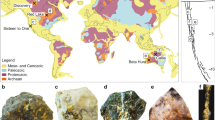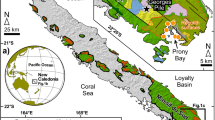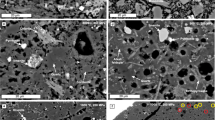Abstract
VEIN-HOSTED gold deposits in low- to medium-grade metamorphic terrains are commonly associated with low-salinity hydrothermal fluids rich in CO2 and/or CH41–12. Fluid inclusion studies of gold mineralization indicate that the ore fluid comprised co-existing CO2/CH4-rich and H2O-rich phases, and that phase separation played an integral part in gold deposition3,5,6,8–12. In hydrothermal solution gold is present as the Au(HS)2− complex13. Precipitation of gold caused by decreasing ligand activity involving the formation of iron sulphides from wall-rock iron oxides and silicates13 is clearly relevant to gold deposits associated with iron formations and iron-rich igneous rock14,15. It cannot, however, be used to explain the common association of gold deposits with black shales or schists3,5,7,8,16, where wall-rock iron is in the form of sulphides, and therefore generally in equilibrium with the hydrothermal fluid, or with granitoids or felsic volcanics, where the amount of iron is low. This latter association may be explained by the partitioning of H2S into the non-aqueous phase during fluid immiscibility10,12, but the general applicability of this mechanism is not known. Here we present a new synthesis of experimental data from a variety of sources which puts this mechanism on a semi-quantitative basis, and suggest that it may be applicable to a wide variety of hydrothermal gold environments.
This is a preview of subscription content, access via your institution
Access options
Subscribe to this journal
Receive 51 print issues and online access
$199.00 per year
only $3.90 per issue
Buy this article
- Purchase on Springer Link
- Instant access to full article PDF
Prices may be subject to local taxes which are calculated during checkout
Similar content being viewed by others
References
Boyle, R. W. The Geochemistry of Gold and its Deposits, Geol. Surv. Can. Bull. No. 280 (1979).
Goldfarb, R. J., Leach, D. L., Miller, M. L. & Pickthorn, W. J. Turbidite-hosted Gold Deposits, Geol. Ass. Can. Spec. Pap. 32, 87–105 (1986).
Read, J. J. & Meinert, L. D. Econ. Geol. 81, 1760–1774 (1986).
Smith, T. J., Cloke, P. L. & Kesler, S. E. Econ. Geol. 79, 1265–1285 (1984).
Bottrell, S. H., Shepherd, T. J., Yardley, B. W. D. & Dubessy, J. J. geol. Soc. Lond. 145, 139–145 (1988).
Walsh, J. F., Kesler, S. E., Duff, D. & Cloke, P. L. Econ. Geol. 83, 1347–1367 (1988).
Boiron, M. C. et al. Terra Abstr. 1, 28 (1989).
Naden, J. & Shepherd, T. J. Terra Abstr. 1, 24 (1989).
Colvine, A. C. et al. Ontario Geol. Surv. Misc. Pap. 139 (1988).
Colvine, A. C. et al. Ontario Geol. Surv. Open File Rep. No. 5524 (1988).
Robert, F. & Kelly, W. C. Econ. Geol. 82, 1464–1482 (1987).
Spooner, E. T. C. et al. Ontario Geol. Surv. Misc. Pap. 136, 35–56 (1987).
Seward, T. M. Geochim. cosmochim. Acta 37, 379–399 (1973).
Groves, D. I., Philips, N., Ho, S. E. Houstoun, S. M. & Standing, C. A. Econ. Geol. 82, 2045–2058 (1987).
Neal, F. & Philips, G. N. Econ. Geol. 82, 1679–1694 (1987).
Ceplecha, J. C. & Wall, V. J. Bull. Aust. Soc. Explor. Geophys. 7, 40 (1976).
Gehrig, M., Lentz, H. & Franck, E. U. Ber. Bunsenges. phys. Chem. 90, 525–533 (1986).
Krader, T., Franck, E. U. Physica B/C139–140, 66–69 (1986).
Haas, J. L. Jr. US. Geol. Surv., Open Rep. No. 78-1004 (1978).
Huang, S. S., Leu, A. D., Ng, H. J. & Robinson, D. B. Fluid Phase Equil. 19, 21–32 (1985).
D'Amore, F. & Tuesdell, A. H. Sci. Geol. Bull. (in the press).
Pichavant, M. C., Ramboz, C. & Weisbrod, A. Chem. Geol. 37, 1–27 (1982).
Fyon, J. A. et al. Ontario Geol. Surv. Open File Rep. No. 5464 (1983).
Weir, R. H. & Kerrich, D. M. Econ. Geol. 82, 328–344 (1987).
Haynes, S. J. Turbidite-hosted Gold deposits, Geol. Ass. Can. Spec. Pap. 32, 161–177 (1986).
Padgham, W. A. Turbidite-hosted Gold Deposits, Geol. Ass. Can. Spec. Pap. 32, 119–134 (1986).
Shepherd, T. J., Bottrell, S. H. & Miller, M. F. J. geochem. Explor. (in the press).
Barton, P. B., Bethke, P. M. & Roedder, E. Econ. Geol. 72, 1–24 (1977).
Vikre, P. G. Econ. Geol. 80, 363–393 (1985).
Brown, K. L. Econ. Geol. 81, 979–983 (1986).
Drummond, S. E. & Ohomoto, H. Econ. Geol. 80, 126–147 (1985).
Author information
Authors and Affiliations
Rights and permissions
About this article
Cite this article
Naden, J., Shepherd, T. Role of methane and carbon dioxide in gold deposition. Nature 342, 793–795 (1989). https://doi.org/10.1038/342793a0
Received:
Accepted:
Issue Date:
DOI: https://doi.org/10.1038/342793a0
This article is cited by
-
Orogenic lode-gold deposits and listvenization processes in the El-Barramiya area, Eastern Desert, Egypt
Environmental Earth Sciences (2023)
-
Geology, fluid inclusion and H–O–C isotope geochemistry of the Doranasai gold deposit, Chinese Altai: implications for ore genesis
International Journal of Earth Sciences (2022)
-
Conditions and processes leading to large-scale gold deposition in the Jiaodong province, eastern China
Science China Earth Sciences (2021)
-
The polymetallic magmatic-hydrothermal Xiangdong and Dalong systems in the W–Sn–Cu–Pb–Zn–Ag Dengfuxian orefield, SE China: constraints from geology, fluid inclusions, H–O–S–Pb isotopes, and sphalerite Rb–Sr geochronology
Mineralium Deposita (2019)
-
Fluid Inclusion and H-O Isotope Geochemistry of the Phapon Gold Deposit, NW Laos: Implications for Fluid Source and Ore Genesis
Journal of Earth Science (2019)
Comments
By submitting a comment you agree to abide by our Terms and Community Guidelines. If you find something abusive or that does not comply with our terms or guidelines please flag it as inappropriate.



